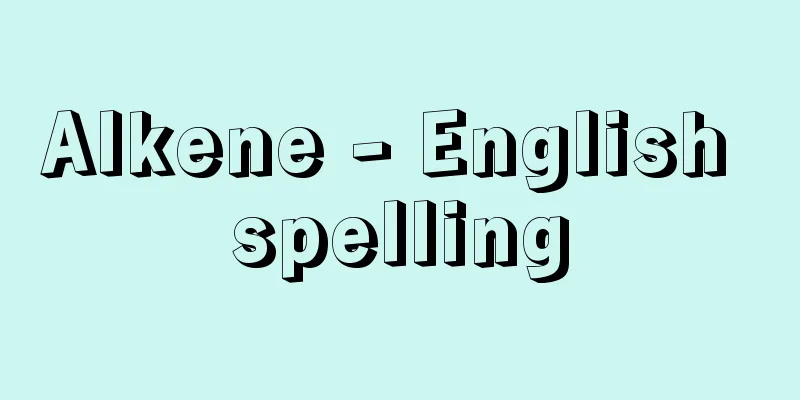Alkene - English spelling

|
A general term for aliphatic unsaturated compounds or ethylenic hydrocarbons with the general formula CnH2n , which are homologues of ethylene H2C = CH2 . They are also called ethylenic hydrocarbons, olefinic hydrocarbons, or simply olefins. In nomenclature, the ending -ane of the name of the saturated hydrocarbon with the same number of carbon atoms is changed to -ene (propene, butene, etc.), but in common names, the ending -ene is added to the name of the alkyl group with the same number of carbon atoms (ethylene, propylene, etc.). [Tokumaru Katsumi] structureEach molecule has one carbon-carbon double bond (ethylene bond) C=C, and the length of this bond is about 134 pm, which is shorter than the single bond of an alkane (154 pm), but longer than the triple bond of an alkyne (120 pm). The double bond of an alkene and the four atoms bonded to each of these carbons are generally arranged in a planar shape. For example, 2-butene, which has one hydrogen and a methyl group -CH3 bonded to each carbon of the double bond, has two structures because the double bond and the atoms adjacent to it are arranged in a planar shape ( ). That is, there is the cis form, in which the two methyl groups CH3- are on the same side of the double bond, and the trans form, in which they are on opposite sides. Rotation around the double bond is unlikely to occur, so the cis and trans forms each exist as stable isomers. However, rotation around the double bond does occur under ultraviolet light, resulting in isomerization between the trans and cis forms. The double bond of an alkene consists of one pair of σ (sigma) bonds and one pair of π (pi) bonds. [Tokumaru Katsumi] Nature/ExistenceAlkenes with four or fewer carbon atoms are colorless gases at room temperature, while those with more than that are liquids, and as the number of carbon atoms increases, they become solids, starting from about 16 carbon atoms. In general, they are poorly soluble in water, but are highly soluble in organic solvents such as benzene. Ethylene and propylene are also contained in natural gas and are also produced during the refining process of petroleum, but they are produced in large quantities industrially by thermal decomposition (cracking) of naphtha and kerosene, which are crude oil fractions. Various alkenes also exist naturally in plants and animals. Compounds with two double bonds in one molecule are called dienes, and among them, compounds with the basic skeleton (C 5 H 8 ) n in which isoprene CH 2 =C(CH 3 )CH=CH 2 is linked in sequence from head to tail are collectively called terpenes and are widely distributed in plant bodies. [Tokumaru Katsumi] Manufacturing methodAlkenes are generally produced by dehydrating the corresponding alcohols with acid or a catalyst.
ReactivityAlkenes have double bonds, which contain pi bonds and can undergo addition with various reagents. Therefore, various substances can be made from alkenes as raw materials. Among them, ethylene is a basic raw material for various chemical products, so its price has a large impact on the prices of various products. Alkenes undergo hydrogen addition over a catalyst to become saturated hydrocarbons (alkanes).
Chlorine and bromine readily add to alkenes, and when an alkene is added to a solution of bromine in carbon tetrachloride, the red color disappears immediately as the bromine reacts with the alkene, making this method a classic laboratory detection method for alkenes. Water can also be added to alkenes in the presence of an acid catalyst to produce alcohols. For example, ethylene obtained from petroleum is added to water under pressure in the presence of phosphoric acid to produce ethanol (ethyl alcohol). Similarly, 2-propanol (isopropyl alcohol) can be obtained from propylene.
When an ozonide is produced by treating an alkene with ozone, the double bond of the alkene is oxidatively cleaved to give a carbonyl compound (aldehyde or ketone). This method has been used as an important reaction for determining the structure of alkenes.
Industrial uses of alkenesNowadays, alkenes obtained from petroleum are oxidized with air or oxygen under various conditions to produce various useful substances. For example, acetaldehyde, an important intermediate in the chemical industry, was once produced by obtaining carbide from coal, which was then made into acetylene, which was then reacted with water using a mercury salt catalyst. However, as petroleum became the main raw material, acetaldehyde was produced by oxidizing ethylene obtained by petroleum decomposition with oxygen using palladium chloride as a catalyst (known as the Hoechst-Wacker process). The same is true for acrylonitrile, the raw material for polyacrylonitrile used in synthetic fibers. This was also previously produced from acetylene obtained from coal and hydrogen cyanide, but is now produced by reacting propylene obtained from petroleum with oxygen in the presence of a metal oxide catalyst complexed with oxygen and ammonia. Epoxyethane (also known as ethylene oxide or ethylene epoxide), the raw material for epoxy resin, is now produced by oxidizing ethylene with oxygen in the presence of a silver catalyst. Another important process using alkenes as raw materials is the production of polymers through polymerization. The resulting polymers are widely used as materials for synthetic fibers and plastics. For example, polyethylene can be obtained from ethylene, but the properties differ depending on the pressure and type of catalyst used during polymerization. For example, under high pressures of 1,000 to 2,000 atmospheres, polyethylene is obtained that is highly transparent and easy to process, but is vulnerable to heat due to the large amount of branching in the chain. On the other hand, when polymerization is carried out at normal or low pressure using a catalyst, polyethylene is obtained that is opaque, strong, and highly resistant to heat and cold.
[Tokumaru Katsumi] Conjugated dienes and polyenesAlkenes in which two double bonds exist with a single bond between them in one alkene molecule are called conjugated dienes. 1,3-butadiene (CH 2 =CHCH=CH 2 ) and isoprene (2-methyl-1,3-butadiene) (CH 2 =C(CH 3 )CH=CH 2) are typical examples. These polymerize much more easily than normal alkenes, producing polymers with rubber-like properties called polybutadiene and polyisoprene, respectively. The latter in particular has a structure almost identical to that of natural rubber. Butadiene can also be polymerized with styrene and acrylonitrile to produce polymers. These polymers are used as synthetic rubber. Generally, compounds with many double bonds connected with single bonds in between are called conjugated polyenes, and as the carbon chain becomes longer, they acquire color. β-carotene has 11 such conjugated double bonds. The red pigment in carrots is β-carotene. Vitamin A is a β-carotene molecule cut in half that has five conjugated double bonds, but is colorless. [Tokumaru Katsumi] "Organic Chemistry from the Basics, edited by Masahiko Iyoda, with Yamamura Kimiaki, Morita Noboru, and Yoshida Masato (2003, Asakura Publishing)" ▽ "Experimental Chemistry Course 13: Synthesis of Organic Compounds 1: Hydrocarbons and Halides, 5th Edition, edited by the Chemical Society of Japan (2004, Maruzen)" ▽ "Organic Chemistry, edited by Kazuhiko Mizuno and Junichi Yoshida (2004, Asakura Publishing)" ▽ "McMurry's Organic Chemistry, Vol. 1, translated by Mitsuaki Kodama, Toshio Ogino, Yoshimasa Fukasawa, Michio Michio, et al., 6th Edition, written by J. McMurry (2005, Tokyo Kagaku Dojin)" [Reference] | | |Ethylene is on the left, propylene is on the right front, and 2-butene is on the right back. ©Shogakukan "> Alkene molecular model ©Shogakukan "> Structure of Alkenes (Diagram) Source: Shogakukan Encyclopedia Nipponica About Encyclopedia Nipponica Information | Legend |
|
エチレンH2C=CH2の同族体で、一般式CnH2nで表される脂肪族不飽和化合物あるいはエチレン系炭化水素の総称。エチレン系炭化水素、オレフィン系炭化水素あるいは単にオレフィンともいう。命名法では同数の炭素原子をもつ飽和炭化水素の名称の語尾-ane(アン)を-ene(エン)に変える(プロペン、ブテンなど)が、慣用名では、同数の炭素原子をもつアルキル基の名称に-eneをつける(エチレン、プロピレンなど)。 [徳丸克己] 構造分子内に炭素‐炭素二重結合(エチレン結合)C=Cを1個有し、その結合の長さは134ピコメートル程度で、アルカンの単結合154ピコメートルよりも短いが、アルキンの三重結合120ピコメートルよりは長い。アルケンの二重結合とそれらの炭素のそれぞれに結合する計4個の原子とは、一般に平面形の配置をとる。たとえば、二重結合のそれぞれの炭素に1個ずつの水素とメチル基-CH3の結合した2-ブテンは、二重結合とそれに隣接する原子が平面型の配置をとるので、二つの構造をもつ()。 すなわち、二つのメチル基CH3-が二重結合に対して同じ側にあるシス型と反対側にあるトランス型である。二重結合の周りの回転はおこりにくいので、シス型とトランス型とはそれぞれ安定な異性体として存在する。ただし、紫外線照射下では二重結合の周りの回転がおこるので、トランス型とシス型との間の異性化がおこる。アルケンの二重結合は1組のσ(シグマ)結合と1組のπ(パイ)結合からなる。 [徳丸克己] 性質・存在アルケンのうち炭素数4以下のものは室温で無色の気体であるが、それ以上の炭素数のものは液体であり、さらに炭素数が増えると、だいたい炭素数16くらいから固体となる。一般に、水には溶けにくいが、ベンゼンなどの有機溶媒にはよく溶ける。 エチレンやプロピレンなどは天然ガスにも含まれており、また石油の精製の過程でも生ずるが、これらは原油留分のうちのナフサや灯油の熱分解(クラッキング)により工業的に多量に製造されている。また種々のアルケンが天然の動植物中にも存在する。一つの分子中に二重結合を2個もつものをジエンとよぶが、そのなかでもイソプレンCH2=C(CH3)CH=CH2が頭と尾で順次連結した基本骨格(C5H8)nをもつ化合物はテルペンと総称され、植物体に広く分布している。 [徳丸克己] 製法一般にアルケンをつくるには、相当するアルコールを酸あるいは触媒と処理して脱水させる。
反応性アルケンには二重結合があり、それがπ結合を含むので、さまざまな試薬により付加を受ける。そのため、アルケンを原料として種々の物質をつくることができる。なかでもエチレンは各種の化学製品の基本的な原料であるため、その価格が各種の製品の価格に大きな影響を与える。 アルケンは触媒上で水素の付加を受け、飽和炭化水素(アルカン)となる。
塩素や臭素はアルケンに容易に付加する。臭素の四塩化炭素溶液にアルケンを加えると、臭素がアルケンと反応してすぐにその赤い色が消えるので、古くからアルケンの実験室での検出に利用されてきた。 水も酸触媒の存在下でアルケンに付加し、アルコールを生ずる。たとえば、石油から得たエチレンに水をリン酸存在下加圧下で付加させエタノール(エチルアルコール)を製造する。プロピレンからは同様に2-プロパノール(イソプロピルアルコール)が得られる。
アルケンにオゾンを作用させ生成したオゾニドを処理すると、アルケンの二重結合が酸化開裂して生じたカルボニル化合物(アルデヒドあるいはケトン)が得られる。この方法はアルケンの構造を決定するための重要な反応として利用されてきた。
アルケンの工業的利用現在では、石油から得られたアルケンを、空気または酸素により種々の条件下で酸化して、種々の有用な物質を製造している。たとえば、化学工業の中間体として重要なアセトアルデヒドは、かつては石炭を原料としてカーバイドを得、これからアセチレンをつくり、これを水銀塩触媒を用いて水と反応させて製造していたが、石油が基幹の原料となるにしたがい、石油の分解で得られるエチレンを塩化パラジウムを触媒として酸素酸化してアセトアルデヒドを製造するようになった(ヘキスト‐ワッカー法という)。また合成繊維に利用されるポリアクリロニトリルの原料のアクリロニトリルも同様である。これも従来は、石炭から得たアセチレンとシアン化水素から製造されていたが、現在では石油から得たプロピレンを酸素とアンモニアと複合した金属酸化物の触媒存在下に反応させて製造される。またエポキシ樹脂の原料であるエポキシエタン(酸化エチレン、エチレンエポキシドともいう)も現在ではエチレンを銀触媒存在下に酸素酸化して製造される。 さらに、アルケンを原料とする重要な過程は、重合による重合体(ポリマー)の製造である。得られた重合体は合成繊維やプラスチックの材料として広く利用される。たとえば、エチレンからはポリエチレンが得られるが、重合を行うときの圧力や触媒の種類により性質の異なるものが得られる。たとえば、1000~2000気圧の高圧下では、透明度が高く加工しやすいが、鎖の枝分れが多いため熱には弱いポリエチレンが得られる。他方、触媒を用いて常圧あるいは低圧で重合させると、不透明で強度が高く耐熱性、耐寒性の高いポリエチレンが得られる。
[徳丸克己] 共役ジエンと共役ポリエン一つのアルケン分子に二つの二重結合が単結合を挟んで存在するアルケンを共役ジエンという。1,3-ブタジエンCH2=CHCH=CH2やイソプレン(2-メチル-1,3-ブタジエン)CH2=C(CH3)CH=CH2はその代表的な例である。これらは通常のアルケンよりもはるかに重合しやすく、それぞれポリブタジエンやポリイソプレンとよばれるゴム状の性質をもった重合体を生ずる。とくに後者は天然ゴムとほぼ同じ構造をしている。またブタジエンはスチレンやアクリロニトリルとともに重合させて重合体を製造する。これらの重合体は合成ゴムとして利用される。 一般に二重結合が単結合を挟んで数多く連なったものは共役ポリエンとよばれ、炭素鎖が長くなると色がついてくる。β(ベータ)-カロチンはこのような共役した二重結合を11個もつ。ニンジンの赤い色の色素はβ-カロチンである。ビタミンAはβ-カロチンの分子を半分に切断した形で共役した二重結合5個をもつが、無色である。 [徳丸克己] 『伊与田正彦編著、山村公明・森田昇・吉田正人著『基礎からの有機化学』(2003・朝倉書店)』▽『日本化学会編『実験化学講座13 有機化合物の合成1 炭化水素・ハロゲン化物』第5版(2004・丸善)』▽『水野一彦・吉田潤一編著『有機化学』(2004・朝倉書店)』▽『J・マクマリー著、児玉三明・荻野敏夫・深沢義正・通元夫他訳『マクマリー有機化学 上』第6版(2005・東京化学同人)』 [参照項目] | | |左がエチレン、右手前がプロピレン、右後方が2-ブテン©Shogakukan"> アルケンの分子模型 ©Shogakukan"> アルケンの構造〔図〕 出典 小学館 日本大百科全書(ニッポニカ)日本大百科全書(ニッポニカ)について 情報 | 凡例 |
>>: Archelon (English spelling)
Recommend
Synthetic leather - gouseihikaku (English spelling) synthetic leather
It is also called artificial leather, synthetic l...
Spherical trigonometry
A calculation method that uses trigonometric func...
Osaka Bank
A regional bank. Founded in 1950 as Osaka Real Est...
Battle of Bunker Hill - Battle of Bunker Hill
An early battle of the American Revolution. On Jun...
Achondroplasia - Achondroplasia
Also known as achondroplasia and fetal chondrodysp...
Aphrodite
...A general term for the annelids of the genus A...
Soga no Umako
Year of death: May 20, 34th year of the reign of E...
John Donne
English poet. A central figure in the Metaphysica...
Industrial action
When a labor dispute occurs, a group of workers r...
《Ofudesaki》 - Ofudesaki
…After the Meiji Restoration, the religion spread...
Crowds - Kuki
〘 noun 〙 In spring, large schools of herring and o...
Squid Kingdom
...A general term for the cultures that existed f...
Hospitalism - hosupitarisumu (English spelling) hospitalism
This disorder occurs when children are separated ...
Rebellion of the Witches - Fukonoran
Civil war occurred at the end of the reign of Emp...
American sennou - American sennou
A perennial plant of the Caryophyllaceae family (...









